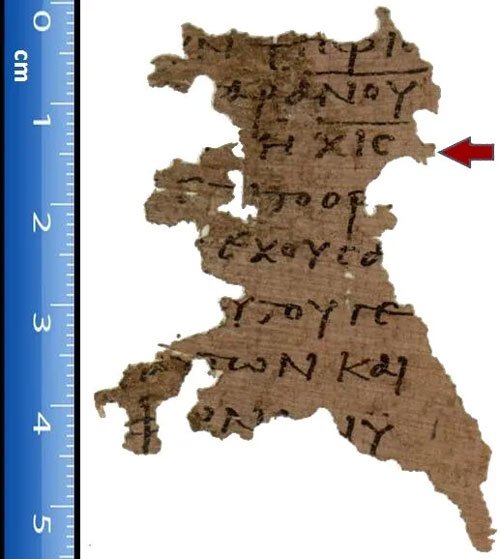Return to: Ancient Biblical Manuscripts
This manuscript contains 26 fragments of a codex containing the book of Revelation. Each sheet originally measured about 15.5 cm x 23.5 cm, with 33–36 lines per page. It is likely that the scribe used a codex that was already bound before he began to his work, inasmuch as the width of the writing on the pages with binding to the right-hand side (i.e., the even-numbered pages) tends to be narrower than those with binding to the left-hand side (i.e., the odd-numbered pages). The difficulty of writing on the right side of the left page thereby can be explained if the pages were already bound.
Significantly, P115 aligns with A and C in its textual witness, which are generally regarded as providing the best testimony to the original text of Revelation. Thus, P115 has superior testimony to that of P47, which aligns with א and together form the second-best witness to the book of Revelation.
An interesting element of P115 is that it gives the number of the beast in Revelation 13:18 as 616, rather than the majority reading of 666, as does Codex Ephraemi Rescriptus.

Writing in the late second century, Irenaeus (Haer. 5.30) was aware of the reading “616” but denounced it as “heretical and deceptive.” He claimed that “666” was found in “all the good and ancient copies” and was “attested to by those who had seen John face to face.” Three significant witnesses (𝔓47 א A) must have their roots in those “good and ancient copies” because they read “666.” However, the recently published P115 reads “616,” as does Codex C. These are among the “good and ancient copies,” and the number they contain, “616,” is not heretical. Either “666” or “616” could be original inasmuch as both symbolize “Caesar Nero.” In ancient times the letters of the Hebrew and Greek alphabets were used as numerals. The “number” of a name is the sum of its individual letters. The number “666,” abbreviated in ancient manuscripts as χξς (χ = 600, ξ = 60, ς = 6), came from a Hebrew transliteration of the Greek for “Neron Caesar.” The number “616,” abbreviated in ancient manuscripts as χις, is either a Latin equivalent of the name “Nero Caesar” by way of gematria (see Aune 1998, 770–771; netmg) or a different spelling of Neron Caesar, which drops the final “n” (Metzger 2003, 308). Both convey the same signification of the same person. As of yet, not one English translation prints “616” in the text, even though several note it. The note in HCSB says that one Greek manuscript plus other ancient evidence read “616.” There are actually two ancient manuscripts.
Some of the information on this page provided by:

James White is the director of Alpha and Omega Ministries, a Christian apologetics organization based in Phoenix, Arizona. He is the author of more than twenty books and is an accomplished debater. He is a professor with Grace Bible Theological Seminary, and a pastor at Apologia Church

Josh Buice is Founder and President of G3 Ministries.
Josh serves as the pastor of Pray’s Mill Baptist Church, a 180-year-old church that hosts the G3 Conference. He studied at the Southern Baptist Theological Seminary, where he earned his MDiv and DMin in expository preaching.
Return to: Ancient Biblical Manuscripts
Have you listened to our podcast, BIBLES * Bulldogs * Beards? Check it out!

